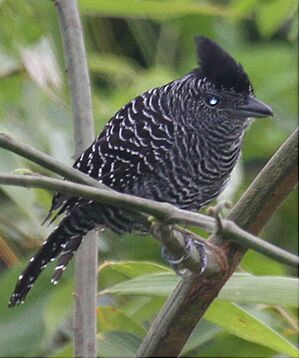Bamboo antshrike facts for kids
Quick facts for kids Bamboo antshrike |
|
|---|---|
 |
|
| Conservation status | |
| Scientific classification | |
| Genus: |
Cymbilaimus
|
| Species: |
sanctaemariae
|
 |
|
The bamboo antshrike (Cymbilaimus sanctaemariae) is a special kind of bird that lives in the Amazon Basin. It belongs to a group of birds called "typical antbirds". You can find this bird in countries like Bolivia, Brazil, and Peru.
Contents
About the Bamboo Antshrike
The bamboo antshrike is a unique bird. It was once thought to be the same as another bird, the fasciated antshrike. But scientists later found out they are different species. These two birds are the only ones in their group, called Cymbilaimus. The bamboo antshrike itself is a single species, meaning it doesn't have different subspecies.
What Does the Bamboo Antshrike Look Like?
This bird is about 16 to 17 cm (6.3 to 6.7 in) long. It weighs around 28 to 33 grams (1.0 to 1.2 oz). Male and female bamboo antshrikes look quite different from each other. This is called sexual dimorphism.
Both male and female birds have a small crest on their heads. They also have dark brown eyes. Their bills are a bit thick and have a hook at the end, similar to true shrikes.
- Males: Adult males have a black forehead and the top of their head. The rest of their body is covered in thin black and white stripes.
- Females: Females have a reddish-brown (rufous) crown. The feathers on their crest have black tips. Their upper body and tail have thin dark brown and pale yellowish-brown stripes. Their throat is a plain, light yellowish-white. The rest of their underparts are mostly a plain cinnamon-buff color, with darker stripes on their sides.
Where Does the Bamboo Antshrike Live?
The bamboo antshrike lives in the western part of the Amazon Basin. This area includes southeastern Peru, western Brazil, and northwestern Bolivia.
- In Peru, you can find it in the regions of Ucayali, Cuzco, Madre de Dios, and Puno.
- In Brazil, it lives in the states of Acre and Rondônia.
- In Bolivia, it is found in the regions of Pando, La Paz, and Beni.
This bird mostly lives in areas with lots of bamboo, especially a type called Guadua. It prefers humid forests in lowlands and foothills. It likes to stay in the upper parts of the bamboo plants. Sometimes, it can also be found in thick tangles of vines in flooded forests, even if there's no bamboo. In these places, it might be seen higher up in the trees. It can live at elevations up to about 1,450 meters (4,760 ft) above sea level.
How the Bamboo Antshrike Behaves
Staying in One Place
Scientists believe the bamboo antshrike stays in the same area all year round. It doesn't seem to migrate or move to different places.
What Does the Bamboo Antshrike Eat?
We don't know all the details about what the bamboo antshrike eats. But we do know that it eats insects. It usually looks for food alone or in pairs. Sometimes, it might join other groups of different bird species that are also looking for food.
It mostly searches for food in the top parts of bamboo plants. It also looks in vine tangles. It can even go as high as 20 meters (66 ft) up in trees that are above the bamboo. This bird finds its food by picking insects off branches and bamboo stems. It also makes short flights from a perch to catch insects. Sometimes, it checks out bunches of dead leaves to see if there are any hidden treats.
How Does the Bamboo Antshrike Breed?
Unfortunately, scientists don't know much about how the bamboo antshrike reproduces or raises its young. More research is needed to understand its breeding habits.
What Sounds Does the Bamboo Antshrike Make?
The bamboo antshrike has a loud and clear song. It sounds like a series of 8 to 15 metallic "tchink" notes that go down slightly in pitch. Its calls include a sharp "tchew!" note, which it often repeats. It also makes a thin, dry rattling sound and a whining "ewwee?" sound.
Is the Bamboo Antshrike in Danger?
The IUCN (International Union for Conservation of Nature) has looked at the bamboo antshrike's situation. They have listed it as a species of "Least Concern." This means it's not currently in immediate danger of disappearing.
The bird lives across a fairly large area. However, its total population size is not known, and it is thought to be decreasing. No major threats have been found yet. The bird is considered quite common in places where it likes to live. But these habitats are spread out and not continuous. Some populations in Brazil, especially in the Rondônia state, could be at risk. This is because forests in those areas are sometimes completely cut down.


